Hi! I played the new Pokémon game, after years and years of never playing any Pokémon games. If all you care about is my favorite monsters from the game, please scroll all the way to the bottom of this gigantic post.
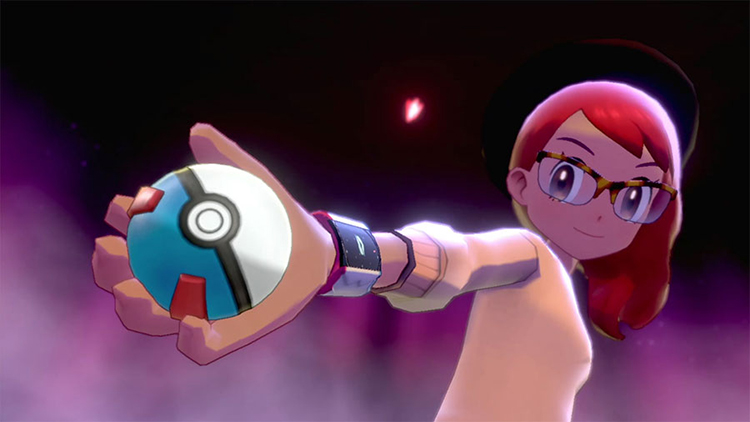
WTF, why did you play Pokémon?
My Pokémon pedigree is pretty slim. I was in high school when the first game came out, playing big boy RPGs like SaGa Frontier and Xenogears. And while even at that time I had a fondness for Final Fantasy: Mystic Quest, I didn’t have much inclination to invest in what looked like an RPG for babies.
Also, at the time, playing games on a handheld for extended periods of time just… hurt. My hands would cramp up and sometimes I would get headaches by squinting at the screen. I had a Game Boy, but the only RPG I owned for it was Final Fantasy Legend II, and playing it was torture. I knew even an RPG for babies was going to be a considerable time investment, so I skipped Red and Blue. A few generations later, around the time I was playing my Game Boy Advance games on a dinner plate the Gamecube plugged into, I had grown out of my RPGs-or-Bust phase. I was largely tired of the genre, and besides, I already hadn’t played the first, what, eight(?) games?
To someone outside the worldwide phenomenon, it’s actually really hard to keep track. As a kid I didn’t like the idea of buying two versions of the same game, only to be hit by a more definitive third version later. As I crept into adulthood I didn’t like how each new set of games in this series were basically just re-releases of the first game with a new set of monsters. I saw it as a scam, and by the time the DS was out and everyone was referring to the Pokémon releases as “generations” I knew some serious Kool-Aid was involved. Nobody in my immediate social circle played the games, they still didn’t look very appealing to me, and I had zero interest in the card game and the anime and all the weird spinoff stuff.
For the longest time, my only exposure to Pokémon was its infection of Super Smash Bros. I’ve always liked Pikachu and Jigglypuff, and I was mostly able to keep track of the guys that would pop out of poké balls in Smash Bros: Melee, but after that it all just started striking me as silly. I thought the inclusion of a Pokémon Trainer character that cycled between the three iconic first-gen starters was inspired, but I thought the inclusion of sorta objectively-bad character designs like Lucario and Greninja were sipping too hard at flavor-of-the-month. (For the record, I still think that, even having a buddy that swears by Incineroar.)
Not long after I started streaming on Twitch.tv, I started doing “viewer’s choice” weeks. Every so often, after hitting some follower threshhold, I’d let my Twitch chat pick a game. Unsurprisingly, Pokémon was one of the first games picked. I played on emulator and spent most of the game trolling chat by giving my monsters dumb names, insisting on using silly-looking monsters, giving all my stat-up items to Jigglypuff, and generally making mock of the whole situation. For the most part my chat were good sports about the whole thing, and we had a generally good time.
And besides, sometimes the facade slipped. I saw glimpses of what makes this series special, even though I wasn’t taking it seriously. I started to understand how someone could slip hard down the rabbit hole of collecting monsters, generation after generation. My insistence on using Pidgey and Jigglypuff, originally intended at being a middle finger at the fanbase, ended up being why the games have a fanbase. Getting attached to certain monsters, for whatever reason, and fixing them up so they’re viable is the core of the game. When I expressed ditress that Vulpix — declared by me to be the cutest of all pokémon — wasn’t catchable in the version I was playing, chat had my back. They hatched a plan to load up my save state in the Pokémon Blue rom, which would “just work” thanks to how game data flowed between the two versions, just long enough to snag an adorable little fox-fellow and then switch back to Red for the finish line.
Still, I knew I wasn’t the game’s target demographic and I knew none of the sequels were going to change my mind on the subject. I had looked at the rabbit hole but I hadn’t dipped my toe in.
Then, a couple of years ago, a game called World of Final Fantasy came out.
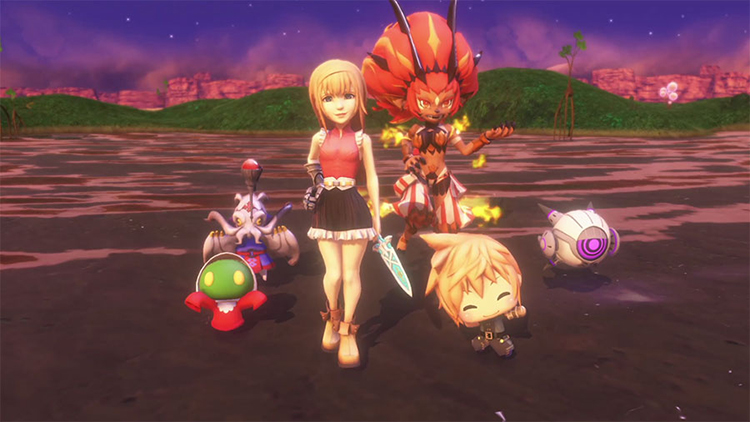
World of What Now?
World of Final Fantasy, released originally on PS4 and later on Switch, is the Final Fantasy version of Pokémon. It’s a game about catching a plethora of adorable little monsters, mostly cribbed from the extensive Final Fantasy mythos. I got the game shortly after it launched and have played it to completion twice. My second playthrough has damn near 100% completion.
In World, you play as two teenagers named Reynn and Lann, and they fight monsters — sorry, “mirages” — by weakening their health level then throwing a magic ball at them. After that they can put the mirage on their head to create a “mirage stack” with all the combined powers and abilities of the component mirages. These powers and abilities are unlocked on a mirage’s individual sphere grid, a la Final Fantasy X.
You catch mirages, then level up your captured mirages, then spend their levels on upgrades in their sphere grid, then synergize them with other mirages in your stacks, all so you can take on bigger and badder mirages. Mirages can evolve forwards, backwards, and even sideways. Some mirages are robots that have slighty different rules. Some mirages are based on NPCs from the story. And all of them pluck at the strings of 30 years’ worth of Final Fantasy nostalgia.
The whole time I was playing and enjoying World, I was completely aware that I was just playing a version of Pokémon. A much better, far deeper version — let’s not mince words — but he core loop of catching/training/combining monsters would have been very familiar if I hadn’t sidestepped the series in high school. I would be very surprised to learn World wasn’t ultimately the product of some Japanese businessman working for Square Enix taking a look at Nintendo’s profits and saying, hey, we need a Pokémon for ourselves.
I bring up World of Final Fantasy chiefly because, as I worked through Pokémon Shield, I had almost the reverse feeling I imagine a lot of Pokémon vets must have had while playing World. Since I had largely approached Pokémon Red as a joke, Pokémon Shield was the first game in its series I was going to be playing by myself and taking somewhat seriously. And the entire time, all 32-ish hours, I kept feeling that World of Final Fantasy had done all this better.
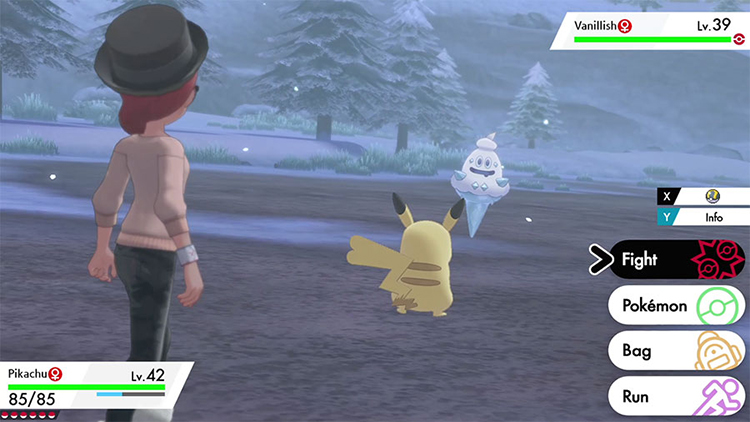
tl;dr
In a nutshell, Pokémon Shield is just Pokémon Red with better graphics. I think it’s a little sad that the gameplay has evolved so little in all that time, and it took another company wanting to ape its success to explore new directions in monster collecting. I realize there are lots of complicated elements at play here, and that we’re dealing with a fanbase that pitches a hissy fit when the slightest changes are made (see “Dexit”, below), but there it is. My one-line review of Shield, as someone who has only played the very first and most recent games in this series, is: they took twenty years and six console generations to land barely an inch from where they started.
Bright Shield, Black Sword
Three things happened which intrigued me about the new Pokémon generation. The first I’ve already outlined: I played World of Final Fantasy, itself largely a modern version of Pokémon, and I was curious to see what the genuine article looked like these days.
Second, while mainline Pokémon is still a handheld exclusive series, the current Nintendo handheld has an HDMI out and controllers that don’t make my hands cramp up and die. For the first time ever, I can play a Pokémon game on my big TV that was actually designed to be seen on my big TV.
And third, this is the first generation of Pokémon I can recall where the two versions seemed… unequal. My feeling as an outsider is they always just pick two related but distinct labels to slap on their games that largely don’t make much difference. Red/Blue. Ruby/Sapphire. Black/White. Ketchup/Mustard. When picking between X and Y, people don’t have much to go on while informing their choice, and so a random choice is as good as any. In actual practice I suspect people comb through leaked monster lists to see which version has better monsters to catch. I’ve also met people who try to figure out which of the two versions is more popular, and getting the other one, to increase their leverage in trading monsters later.
But Sword/Shield strike me as following an inherently different dynamic. Swords are inherently more exciting than shields. Every fantasy hero in history has a magic sword, and every magic sword has a name. Excalibur. Andúril. Grayswandir. Needle. The perception amongst fantasy consumers, of which there is a great overlap of Pokémon players, is that swords are cool and shields are… what you might use in your other hand.
Nintendo’s biggest fantasy series is, of course, The Legend of Zelda. In basically every Zelda game since 1990, unlocking and weilding the Master Sword is one of the high points. With the possible exception of Breath of the Wild, locating the Master Sword is the beginning of the game’s more open, more heroic second act. The Master Sword is so iconic they’re putting the dang thing in Super Mario Maker.
Link’s shield, simply called “Hylian Shield”, is iconic too, but mostly just because there’s a triforce on it. Usually you buy it in a shop somewhere and hope a likelike doesn’t eat it. Big whoop.
As sexy as swords are, though, I’ve always personally liked those few fantasy heroes who are more associated with shields. A shield is protection. It is stoic and unmoving. It’s defense of home, heart, and high ideals. Suikoden II — one of those big boy RPGs I was playing instead of whatever flavor Pokémon was out that year — plays with this idea a lot. The shield hero, your player character, stands resolute against the sword hero, who becomes an engine of bloody destruction. Or consider Thorin Oakenshield, a hero not for leading his people to some great victory, but simply defending them from monsters in the face of annihilation. Or Jon Snow, whose magic sword with the cool name wins countless victories, but his most crucial was won by catching his enemy’s arrows in a muddy and un-named shield that had been discarded on the battlefield.
My point is, the terms “sword” and “shield” carry a lot of baggage that previous Pokémon titles simply don’t. The terms have strong connotations both in fantasy literature and in practical real-world application. Which one you pick can say something about how you might approach a game that is largely about endless battles, in a way that picking a gemstone or a potato chip flavor doesn’t.
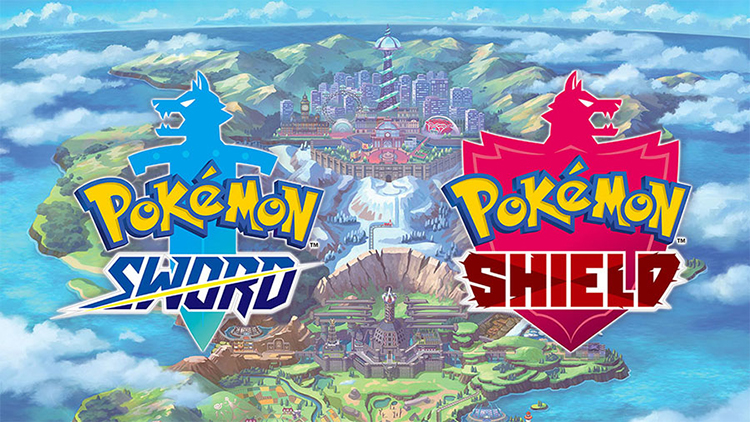
My feeling was that most Pokémon players would pick Sword over Shield because of the perceived strength of the weapon over the piece of armor. I also figured there would be some mechanical purpose to this. The version you buy determines which legendary monster you get at the end of the game, and most people perceive swords as being stronger. Or, at least, a “sword” character is probably more fun to play as than a “shield” character. As anyone who has played a tank or a healer in an MMORPG can tell you, the defensive role is necessary but not nearly as popular as the flashier and more visible dps roles.
I can’t find any sales numbers for the individual games, only combined numbers that tell the story of this new Pokémon smashing records left and right, so I don’t know for sure whether my gut was right about this. I do know that one day I was in a store and all they had on the shelf was Pokémon Shield, and that was true two days later at another store when I went to pick up my own copy.
Why people said they were boycotting the most popular Pokémon game ever.
I don’t want to dwell on this “Dexit” “controversy” too much, except to point at it and say it was a thing that happened and then move on. As someone who hasn’t played a game in this series since Red I didn’t much care which monsters would and wouldn’t make the cut. I also don’t like to get too involved in fandoms where whiny toxicity is in greater supply than showering. (Which is to say, any and all fandoms.)
My understanding of what happened is this.
Pokémon Sword/Shield is the highest-fidelity Pokémon title to date. The graphics, sound, and general gamefeel were expected to be a head-and-a-half higher than the previous installment at least. The developers were under a lot of pressure to make the biggest, most beautiful Pokémon game ever, in addition to the usual pressure of introducing a huge amount of new monsters to find and catch.
They squared the circle by cutting more monsters from the overall roster than previous titles had. A quick glance at Bulbapedia reveals that Pokémon Sun/Moon had over 800 monsters when it was all said and done; Sword/Shield have about half that. In other words, chances were pretty good your favorite monsters weren’t in this new one.
Jigglypuff and Pidgey were out. If I were a fanboy, that’d have been my cue to rant and rave.
Many called for boycotts, others made angry YouTube videos. Of course, judging by the sales figures and smashed records, all those nerds went out and bought the game anyway. Sound and fury, signifying nothing.
I feasted on the butthurt for a while, but honestly I didn’t think about Dexit at all as I played. There are way, way, way more monsters in this game than you could conceivably use. I spent huge amounts of time in each area to make sure I “caught them all” only to be surprised later and find out there were tons in each location I had missed.
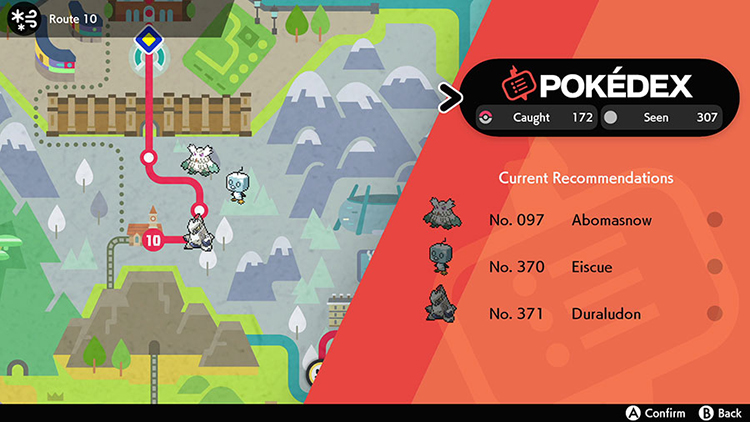
(I looked up the roster for World of Final Fantasy, by the way, and it has about half as many mirages as there are monsters in Sword/Shield. It’s an inexact comparison, considering the mirages in World are component pieces in a much larger number of possible mirage stacks. But I still found it interesting.)
The Gameplay Loop
Of the hundreds and hundreds of monsters in Pokémon, you pick six to form a core team. Each monster on your team has four somewhat customizable moves. You pit your team of six against wild monsters and other trainers’ teams in a series of 1v1 battles. Each monster and each move has a “type”, and certain types are weak to and strong to certain other types. Your goal is to build a team that can hit as many type weaknesses as possible, and to pick moves your opponent is weak against without opening your own monster to its own type weaknesses.
That is well north of 95% of everything you need to know to be successful in Pokémon.
I think this is what shocked me most about the game, coming into it from World of Final Fantasy. Enemies in World also have elemental weaknesses, and a big part of the game is mitigating the weak points of one monster by putting another monster with opposing weaknesses in the same stack. A fire monster in your stack makes it more weak to ice, for example, but pairing it with an ice monster mitigates that weakness somewhat, making a stack that is pretty neutral against fire and ice attacks. Or you could double down on the fire monsters, which bolster the strength and selection of fire magic available to your stack. If you’re in a predominantly icy area, what’s the better play? Shore your fire guy’s weakness up with an ice guy’s defense? Or double down to get the big-hitting fire magic in an area where your doubly-bad ice weakness is going to be a liability?
There are a ton of moving pieces to play with when you get passed type weaknesses in World, is the crux. Lots of interesting decision points, lots of risk and rewards. In Pokémon there’s nothing back there but… well… nothing.
Now, fanboys of the series have been telling me for years that there’s a lot more to the Pokémon formula than just type weaknesses. These folks aren’t wrong, but I don’t think they’re right in any way that’s helpful to the most common play experiences. The biggest factor in which monster wins the 1v1 duel is their level, not their type. And high stats can mitigate type weaknesses in both directions; a monster weak to ice but with a high Sp. Defense stat will be able to weather an ice attack just fine, even though it’s “super effective”. Individual moves are also either physical or special, each one targeting a different defensive stat. So sometimes it matters whether your have a physical fire attack or a special one.
The only interesting decision, though, is the type of your attack. You’ll never be fighting against pokémon of a much higher level, and the pokémon you fight have more or less average stats. If you do run into one that can mitigate a physical fire attack, and you don’t have a special one, the fallback position is to just use neutral specials that don’t hit a type weakness but still deal enough damage that you’ll win the fight.
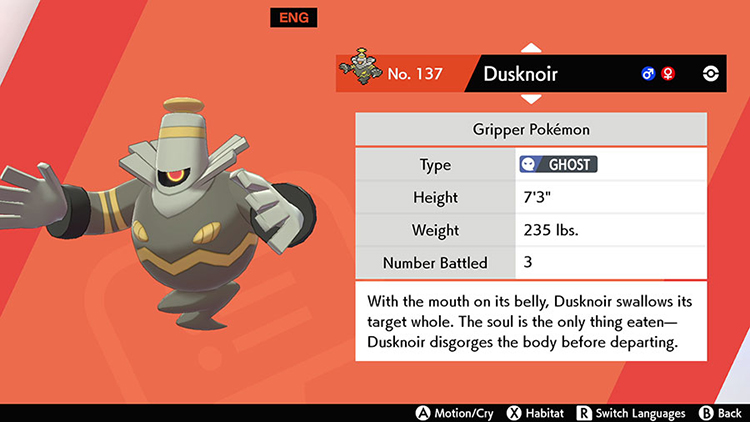
If you’re a new player, like I am, there’s still a lot of room to get lost in this system. There are about two dozen types of pokémon, and the types don’t always form clear loops or oppositions. You’re also not told the type of a monster the first time you encounter it, and the game is rigged so a lot of storyline battles have you seeing monsters for the first time. (Indeed, according to Bulbapedia, lots of these encounters are stacked with monsters exclusive to the other version of the game!) You sometimes have to make guesses about what a monster’s type is, and then remember which of the many opposing types to use, and it’s very possible to guess wrong. I was personally a bit miffed when I fought this floaty metal-looking guy called Dusknoir, and only narrowly winning my fight against it, only to catch one later and learn its weakness is Dark attacks.
But guesswork, intuition, and eventually applied game knowledge win out in the end. Any player who is paying even a little attention is going to have a gaggle of overleveled monsters with all types covered by the third or fourth area. From there it’s Steamroll City. Most of the boss encounters are against opponents who use all of one type or another, and you know the type ahead of time. So it’s trivial to roll up and one-shot all their pokémon in a row.
Any mistakes you make are easily smoothed over by the functionally limitless supply of healing and revival items you have at all times; the game showers you with these after every NPC encounter, and they sell for pennies at the convenient Poké Mart. If you’re awake, you will never lose a fight.
On a macro level, the game is linear and structured. You beat the eight themed boss guys one after another, then you go fight the big bad, then you go around the eight themed boss locations again to do some other thing, then you go fight another big bad. Every step of the way has 1v1 bouts where you’re looking for type weaknesses.
Most of the boss fights involve the Dynamax system, where your opponent’s pokémon grows into a giant. I don’t actually think this effects anything. A Dynamax’d monster’s base stats are larger, but stats are secondary to types, so I was still carving through huge amounts of Dynamix’d health bars by hitting type weaknesses. Most Dynamax fights allow you to Dynamax your own pokémon too, so the sense of scale is usually immediately lost.
Most of the nuance of individual moves gets lost, too, each one just becoming a generic version of whatever the attack’s type was. I had a pokémon with two poison-type moves. One applied a damage over time poison effect, the other dealt double damage to a poisoned target. I won a lot of fights with this combo even against monsters without a poison weakness. When Dynamax’d, though, both poison moves just turned into “Max Ooze”, which still did damage but didn’t set up what I thought was a clever combo.
There are two kinds of 2v2 battles in the game. In the first kind, another AI-controlled pokémon trainer fights alongside you, using their own monsters. In my experience these fights always turned into a 1v2 match, since the AI trainer is usually ridiculously stupid and underpowered. In these fights you sometimes get a free round as both enemy monsters target the AI guy instead, but otherwise there’s nothing more to them.
The other form of 2v2 match were the most interesting fights for me by far. In these fights you control both monsters on your side and battle against two opposing monsters. This brings Pokémon more in line with traditional JRPG party combat, which is to say Dragon Quest. It’s nothing special in and of itself but it highlights just how restrictive the more common 1v1 style battles, and therefore most of the rest of the game, actually are.
I think my ideal Pokémon game would have the 2v2 format as the default, allowing you to cart around a team of eight monsters arranged in pairs, with the option to hotswap individual monsters or one pair for another. Maybe have some synergy bonuses if you pair monsters of similar or even opposing types. This actually gets pretty close to what World of Final Fantasy‘s default battle system looks like, though, so I guess I already have that.
World of Pokémon
Pokémon Shield takes place in the Galar region. (I assume Sword does too.) It’s pretty standard JRPG fare: you alternate between moving through monster-filled outdoors areas and safe village areas in your ever-expanding quest to trigger the next plot flag. For the most part I found navigating through the enemy areas to be the most enjoyable part of the game.
My recollection of Pokémon Red was that the enemy areas were linear stretches that all looked and felt the same. There wasn’t much an original Game Boy game could do to have a “fire area” or “ice area”, so the whole journey took part in these narrow stretches of grassy terrain with short cliffs and lots of weeds. Shield mostly follows this trend, but the attention paid to making each area feel distinct really does make all the difference.
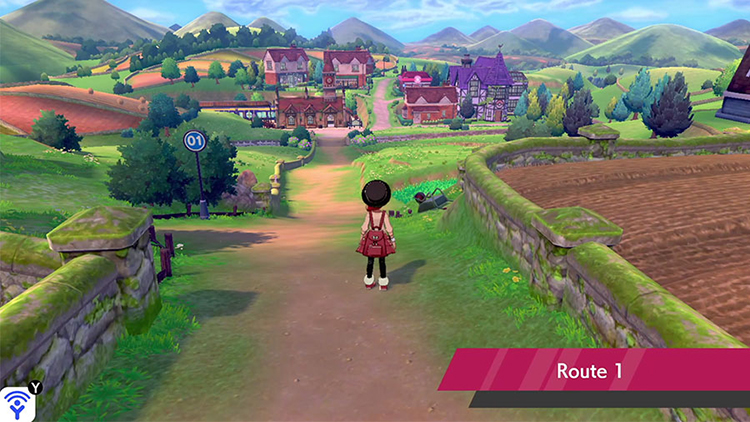
We’re not into full-on Dungeon Man territory here. You’re still running or biking through stretches of flat terrain, avoiding or navigating weeds depending on your current tolerance for random encounters. But the overworld areas do have little gameplay features that help bolster the sense-of-place a bit. The mountain area has lots of tall ladders and narrow crevices. The dark forest has luminous mushrooms you tap to light the path. The ice area has you riding your magic bike from iceberg to floating iceberg.
My problem here is that these areas are just too short. Each one is barely a few minutes long; if your only goal is to get through them, you might see two or maybe three encounters. Even if you want to explore everything and find every hidden passage and poké ball, the game always heavily skews towards town exploration, cutscenes, and NPC dialogue. Getting this closer to a 1:1 ratio would have been preferable.
There’s two more reasons I’d have liked to see longer areas. First, there is a sicknasty number of new monsters to catch in each new place you visit, more than you can possibly see even if you’re being thorough. Longer areas means you have more chance to see more kinds of monsters. Heck, you could then even justify having sub-areas with a different encounter list. No matter how you slice it you’re going to spend a lot of time just running circles in the patch of weeds closest to the next village. Another screen or two along each route means another monster or two in your Pokédex, and a few dozen circles you don’t have to run.
And second, longer areas means more reasons to re-visit old areas you’ve already cleared. This is an element I remember from Pokémon Red that simply isn’t in Shield. In that game, at key moments, you learned special monster moves that could open paths in more organic ways. Say there’s a huge tree blocking the next area off. Teach one of your guys the Cut move, and now you can get through that tree. And hey, wasn’t there a tree or two in the previous area you should go check out now?
Shield only did this once, with the magic water-skimming bike. I had a good time going back to the few areas that had water paths I could check out, now, but not quite enough to really sate my sense of exploration. Notably, there’s no way to open up new paths at all in the game’s two cave areas, which seem pointless compared to the variety of pathing out on the routes.
I say I wanted “longer” routes, not “larger” ones, because there is one area of the game that is vast indeed: the Wild Area.
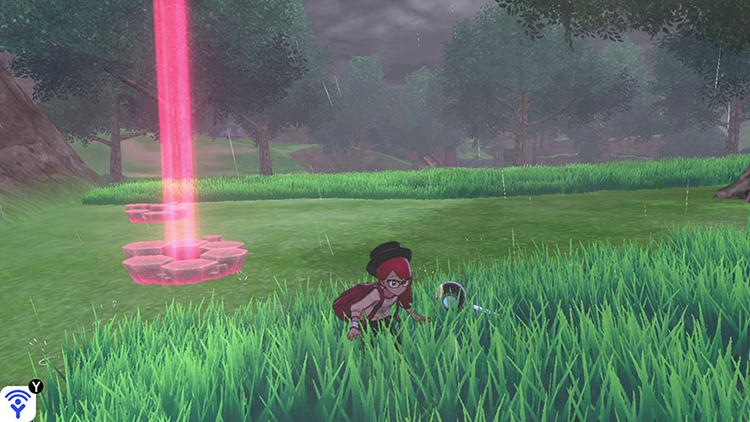
I’m sure someone out there thinks the Wild Area is Pokémon dabbling in being open world, but I should hope even the most stout Nintendo fanboys can see through such a silly notion. The area really isn’t even that big, though the two times you need to traverse it certainly take longer than any of the other routes.
What makes it feel more expansive is the large number of things to do. There are big sections of tall grass scattered across the landscape, each with a varied list of monsters that can appear in different weather. There are bridges and trees and ruins, and lots of water, and fishing spots too. And a special currency you can only earn and spend here. There are also high level pokémon roaming around you can’t really fight on your first visit, and that you’re not allowed to catch even if you could fight them. Oh, and there are pink holes in the ground where you fight wild Dynamax’d pokémon.
Or you hop on your bike and ride to the next place in three minutes.
Lots of characters implore you to go back to the Wild Area to get stronger and catch more pokémon. And I did spend a lot of time there, over the course of three treks: the first to reach a city in the middle of it, the second to reach another city at the far end of it, and a third to bike across the water to a few previously-unreachable islands.
Other than that, though? And the general novelty of an “open world”? I don’t see the point. There are a lot of monsters to catch, sure, and I did spend a lot of time there on each of my three outings, but the game kept trying to sell me on this idea that it was a central important location to my development and I just wasn’t buying it. I was always able to catch new pokémon on whatever the next route was, after all, who would all be at or around my own team’s level. Revisiting the Wild Area just never felt like it’d be worth my time.
I kept expecting a second Wild Area to open up, maybe at or near the endgame, to justify what must have been a lot of development time on what is kind of being billed as a key game feature. A huge underworld area or a vast untamed jungle — wait, didn’t Red have that already? — filled with more powerful monsters than anywhere else in the game.
As it is, the one Wild Area is all you get. The whole place is surrounded by walls and high cliffs, and no matter where you stand you can always swivel the camera and see the huge cities that sit next to it. It doesn’t feel like a Wild Area. It feels like a damn zoo.
Unlike on the routes, where you’re always a screen or two away from a full heal, out in the Wild Area you will probably run low on resources and have to camp. Camping is a new feature in Shield, from what I can tell, and I expect a lot of players will spend hours and hours there, talking to their monsters and playing with toys and cooking.
I detested the camping screen because I only did it when I needed to heal up, and healing up meant playing the inane cooking minigame. Here’s how it works: first hammer the button, then spin the thing, then you’re done. These two steps take about a full minute each. There’s no skill involved and as far as I can tell there’s no difference between any of the game’s hundreds of different cooking ingredients. You always make curry and it’s always tasty and you always get healed up after eating.
So that’s a lot of words to basically say “here’s a dozen gameplay systems that don’t matter because it’s all about types”. I enjoyed my time playing Shield, but there is just no meat in this stew. It tastes good going down but doesn’t fill you up, and it’s surrounded on all sides by heartier meals you will remember for much longer.
A wild “WELL ACTUALLY” appeared!
People are going to yell at me for calling Shield (and all other Pokémon games, by extension) overly simplistic without mentioning online competitive play. So I’m going to mention it and then move on.
I have not played any online vs. matches and never will. Doing so would be completely pointless without a L100 team at the very least, and I have no desire to grind that long. (My over-leveled endgame team is only about L72.) Even if I did, I don’t much like competitive games.
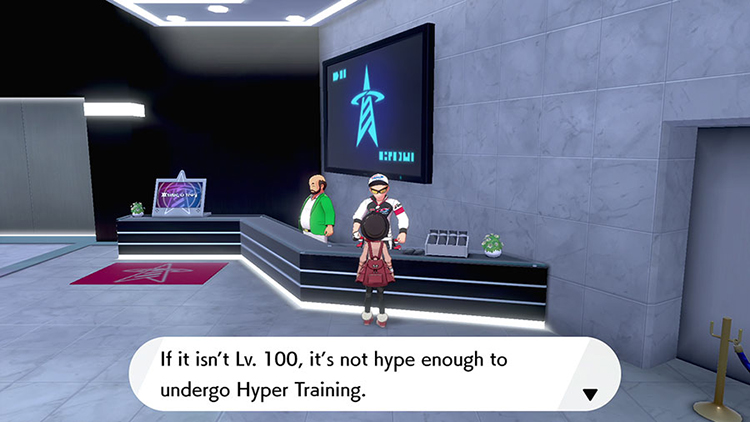
That a game can be played between humans, each trying to win, does not necessitate that game be deep or complex. Each year in Gloucester a bunch of people compete to see who can catch a big wheel of cheese that’s rolled down a hill. I don’t doubt for a minute that some people take this very seriously. Many people have been injured by falling down the hill after the cheese, or by the cheese itself as it crashes or bounces unexpectedly. There are certainly people who train all year for the big cheese-chase. For some people it will be the only moment of glory in their lives. People visit from all over to compete and to cheer and I’m sure its the high point of many folks’ year.
But it’s still just rolling cheese down a hill, yeah?
It’s 👏 For 👏 Little 👏 Kids!
Pokémon Shield‘s story is boring and stupid. This game talks at you a lot for how much actual development occurs over the course of the game.
The first knee-jerk might be something like, “Who cares about story in a Pokémon game?” And the answer is: Nintendo does. (Or technically GameFreak I guess, but also yeah, Nintendo cares an awful lot.) Someone created these characters and this world and wrote reams and reams of exposition. There’s an ancient legend to discover and some characters have motivations and even change sides during the plot. Someone cares a whole awful lot that this game feel like it’s telling a story.
But oh my god does it suck.
Let’s start with the most common defense: that it’s a game for kids. That’s true, of course. One helpful Twitterer I saw even punctuated the point with a clapping hands emoji, so you know they were super serious. The story is for little kids so if you’re an adult that didn’t enjoy it, well, you weren’t the target demo.
I don’t buy this logic and I never have. I think it does a disservice to children to imply they can’t handle or wouldn’t like better stories. It leads to a lot of companies shoveling just the worst kinds of boring dreck because they believe kids will like any terrible thing they poop out. I hesitate to even use qualifiers like “more complex” here, because my issue with Shield‘s story isn’t that it’s simple, but that it’s stupid. I would implore anyone clapping their hands to the “IT’S FOR KIDS” mantra to watch a few Pixar movies, or Avatar: The Last Airbender, or read some Harry Potter, and see how the masters craft stories for children that still hit basic narrative goals like “rising and falling action” and “has conflict” and “character motivations make sense.”
The story of Pokémon Shield is as follows: your player character lives next door to the current Bestest Pokémon Champion, and his little brother is your best friend. One day the champ visits home and gives each of you a pokémon of your very own, so you decide to enter the Pokémon League. This involves fighting at the eight gyms throughout Galar and then competing in a big tournament in the capital city.
Meanwhile, the sponsor of the tournament is doing some… nonspecific… bad(?) thing that’s connected to an ancient myth where two legendary pokémon protected Galar from a giant Dynamax’d monster in an event called the Darkest Day. The sponsor guy accidentally(??) summons the big monster, so you and your friend and the champion guy beat it up.
At this point two more bad guys(?) show up with a second evil plot to make a bunch of pokémon Dynamax against their will. They plan to end with the legendaries who helped beat the big endgame monster. (The big endgame monster, by the way, currently resides in a poké ball in your party, and your Mum likes it, and your other pokémon will play with it and you can make it eat curry and every other dumb thing.) You succeed at saving whatever legendary is on the box you bought, while the other one gets pokénapped. By the time the bad guys realize they’ve lost control of the situation, you and your friend team up to calm the “bad” legendary down… and that’s it. You have one last battle with your friend and are then nudged on to an endless battle tower and (presumably) online vs. play.
The characters and the writing, by the way, are fine. I enjoyed the cast. You meet lots of people, and while they’re mostly just colorful cliché machines, I never actively hated any of them. There are some fun interactions and you sort of do get a sense of what you’re all working towards, in the end.
What people mean by “the story doesn’t matter” is that, in a Pokémon game, the gameplay loop of catching and leveling monsters is what it’s really all about. This is true of every video game. I always say great gameplay can carry a blah story, while a great story can’t save a game with blah gameplay. Shield‘s gameplay isn’t great, but it definitely isn’t blah. It was enough to carry the experience for me, and I expect it’ll be the draw for most players.
That being said, it would have been close to trivial to give this game an actually compelling story, and a version of this game with a compelling story would have been improved dramatically over what we actually got.
The problem isn’t really that it’s boring (although it was boring), it’s that story beats and worldbuilding notes don’t withstand even basic levels of scrutiny. It only takes two seconds to think about what happens in the game and realize there’s no way it could possibly happen that way.
That’s really the difference between “good” and “bad” For-Kids media. A good story, whether made for kids or not, can stand up to some basic questions. Maybe not intense frame-counter-grognard-with-a-youtube-channel-and-a-chip-on-his-shoulder questions, but basic stuff about surface-level logic.
Stuff like… why are you the only pokémon trainer in the world who actually plays to win? Using a variety of pokémon with moves of all different types is the obvious best strategy, but everyone you meet either uses a small amount of monsters or all monsters of the same type. The gym leaders are supposed to be some of the best trainers in the business, but my preteen trainer with no experience destroyed most of them with a single move, then destroyed them again later in the same way at the tournament.
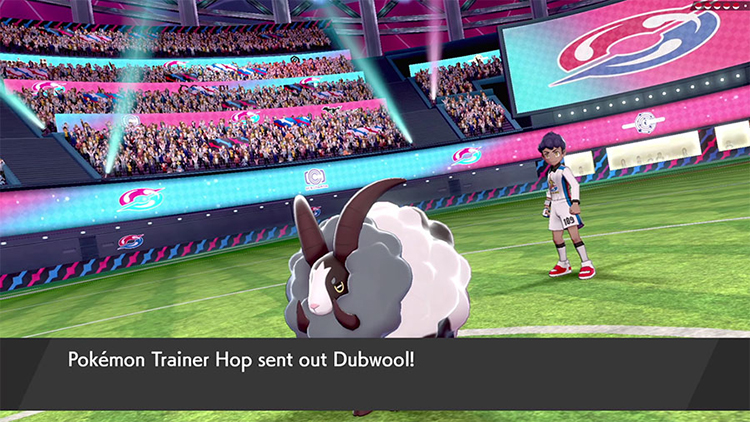
Or… why has nobody ever pieced together the legend of the Darkest Day before now? Your professor friend figures out the specifics of Galar’s biggest mystery by visiting every village and speculating about what the mural or statue or whatever in each one means. She looks at the artwork, thinks about it for a second, then declares what it must mean in the context of the other artwork she’s seen. Has nobody ever done this before? Nobody’s ridden the train from one side of the region to the other to visit all, what, six or seven landmarks? Wikipedia doesn’t exist in Galar?
You don’t even need explanations for these things, just acknowledgements. Maybe most people only have aptitude for one or two types of pokémon, and that’s why your character (and the current champion) are special. This is how it already works in practice, just have an NPC or two point it out along the way.
I know a compelling Pokémon story is possible, because I watched Detective Pikachu and it was thoroughy enjoyable. But they didn’t bother to try with Shield and I think that’s a shame.
Muh Bois
I think that about covers everything I could possibly say about Pokémon Shield. I enjoyed the gentle romp and will probably revisit the game in a couple years, maybe when the next generation comes out, using different monsters or maybe trying a challenge run. I look forward to the GDQ marathon where they run Shield and I actually care about the annual Pokémon run for a change.
In closing, I’ll leave you with my team. I didn’t give any of my monsters nicknames because pokémon already have super silly names as-is.
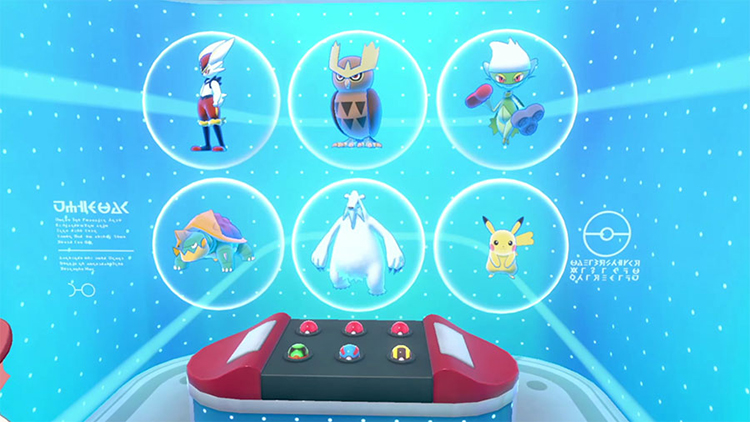
Cinderace was my starter. My recollection from Red was that I put my starter (I think Squirtle, or whatever Squirtle evolves into) in a box partway through the game, and I was expecting to do that here, but Cinderace was consistently one of my strongest fighters for the entire game. It was rare to find an opponent faster than he was, and I got him a held item that increases the power of fire attacks very early on. So many monsters in this game seem weak to fire. Cinderace solo’d two of the gyms and shut down my stupid rival and his stupid Wooloo every time they popped up. I considered throwing him away when I saw how derpy his second-level evolution looked, but the final form is the Trix rabbit on bath salts and I’m into that.
Noctowl ended up being my best generalist. HOOTS the Pidgey(ot(to)) was a pretty big part of Brickroad Pokémon lore, so when I met a new(?) pokémon named Hoothoot I knew I had to have him. I think the one I captured was actually a Dynamax fight from the Wild Area. Anyway, Noctowl ended up with Flying, Fairy, Psychic, and Steel attacks, making him a pretty good bet against lots of random fiddly types I couldn’t remember the weaknesses for. Chances were good I could cycle in Noctowl and land something in a couple of tries, especially after I gave him an item that damages anyone who lands an attack on him.
Roserade was my secret MVP. He’s also one of only two pokémon I evolved using an item. (The other was an Eevee, because I remembered how Eevees work from my time with Red.) Lots of pokémon need items to evolve, but I didn’t feel like rubbing my entire inventory against the entire catalog. The game will show you if an item you’re selecting works on a pokémon in your current team, though, so Roserade got evolved in the end. His Toxic/Venoshock combo was super good against anything I knew wouldn’t resist poison, and its Giga Drain attack gave it mad staying power against some of the stronger gym leaders. Oh, and if you punch it, you get poisoned by that too, so sometimes I didn’t even have to use Toxic. Roserade delivered the final blow against most of the endgame fights. I love the idea that one of the fiercest pokémon on my team looks like it has cupcakes for hands.
Drednaw is the very goodest boi. He had pretty great HP and defense stats, so I could count on him lasting a few rounds if I needed to spot-heal. Water also seems to have as many damage applications as fire, although for most of the game I had other water options available. I eventually gave him False Swipe, so he could help me capture low-level pokémon in areas I missed the first time. (False Swipe is a move that can never kill an opponent, allowing you to weaken it without killing it, something that’s basically impossible if the opponent is ten or more levels lower than you.)
Beartic started life as a teddy bear with a big snot dangle, and was the first ice-type whose character design I didn’t hate. (The other main ice types I’d found were a vanilla ice cream cone and a penguin with an ice cube for a head. Pass.) Beartic has an ice move that always critical hits, and eventually learned a move called Superpower that has an insane attack rating to go with his insane Attack stat. He was a good meat shield to put out first in some battles where I wasn’t confident about the types my opponent would use. Also the game says he’s “quirky” by nature, which I like to think means he does abstract fingerpaints with those huge claws of his.
Pikachu rounds out my team, but I actually didn’t have a sixth for most of the game. I used it mainly as a rotating guest slot for whatever I happened to get in each area, and spent some time trying to find a use for lots of monsters I thought looked kind of cool. For a while I used the not-really-final-boss pokémon in my sixth slot, you know, the one that was going to destroy Galar or whatever, but it was pretty underwhelming and stupid looking. I actually thought Pikachu might be Sword-only, since I fought against a trainer who had one but never found any myself. Turns out it’s just a kind of rare encounter. (The same area is lousy with Eevees, I had two of those.) As soon as my pokédex confirmed I could go back and catch one, I cycled Drednaw and his False Swipe to my top slot and the rest is history.
Thank you for reading all my dumb bad opinions about Pokémon!
You hit most of the reason I don’t really care about new Pokemon games. Rather than improve the mechanics or take the series in interesting new directions they just added more and more Pokemon. By the second game there were already 250 of the things, that was more than enough and I don’t care to learn the types and names of another 750.
I’ve played the first two generation games a good number of times and watched the anime religiously as a kid, but I have no interest in anything past Gen I or Gen II at the most.
It always bothered me that Professor Oak and Bill both only knew about 150 pokemon when there were a thousand more if they had ever bothered to speak to anybody from a neighboring region…. In a world with video phones.
” Doing so would be completely pointless without a L100 team at the very least, and I have no desire to grind that long. ”
Glad to see your review utterly fails to comprehend basic facts of the game.
Of course, the moment you said the game just plays like Pokemon Red is laughably pathetic, and shows how little you actually bothered to look into game mechanics. And World of Final Fantasy, while not bad, is infinitely shallower than any Pokemon game.
Multiplayer automatically scales Pokemon down level 50 no matter how high your level is. Only a handful of rare, high end Pokemon even get anything from leveling beyond 60 or so.